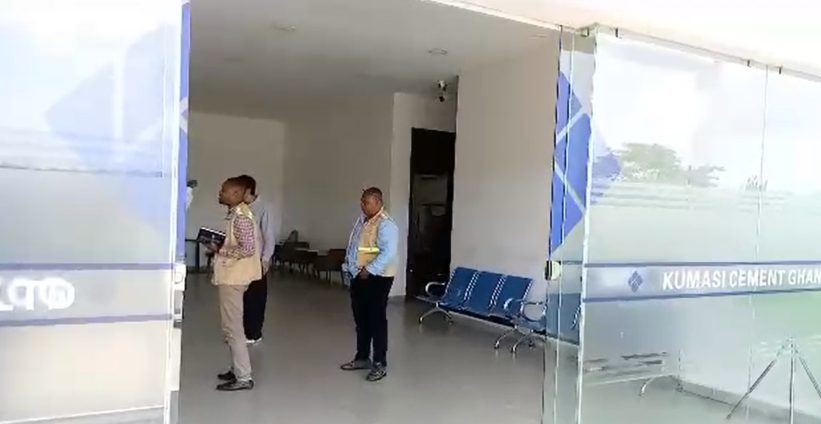
ELECTORAL COMMISSION OF GHANA
The case for a New Biometric Voter Management System and New Voters Register
Good morning ladies and gentlemen from the media.
On behalf of the Commission, we are pleased to welcome you to today’s Press Briefing.
The Electoral Commission intends to procure a new Biometric Voter Management Solution ahead of the 2020 General Election.
The Commission took the decision based on the advice of its IT team and external Consultants to the effect that, it would be prudent to acquire a new system rather than refurbish the current system. In the view of the experts, the cost of frequent replacement of failing parts and the renewal of warranties through third-parties was comparable to the acquisition a brand new system with full service and warranties. In effect the amount of money spent on refurbishing parts and renewing warranties could be used to acquire a brand new system that is robust, modern and durable user friendly with full functionality and warranties.
• It is important to note that the equipment that the entire voter management system runs on, from enrollment, deduplication, adjudication to voters verification is obsolete and no longer supported by their Original Equipment Manufacturers (OEM). The report from the immediate past vendors of the solution indicated that the Commission would assume so much needles risks if steps were not taken to change the equipment.
In a letter from our previous vendors the STL dated the 19th of November, 2018 they stated as follows:
“We would like to remind you that in 2016 the registration we had in total 47% failure rate for BVRs during the preparation to registration period. We had high rate of failure of prepare kits which were sent to the registration centres, which created a challenge during the registration.
The BVR kits are more than 7 years old and End-Of-Life (EOL) and can hardly be supported. Please refer to a letter we have received from our suppliers, HSB earlier this year.
Please note that the tests were conducted 11 months ago”.
In the said letter from HSB partners of STL dated 18th May, 2018 they stated as follows:
“We would be like to announce that the items in the present BVRs are End- of-Life including laptops. This means that no components are available to repair the items. For purposes of availability, maintainability and compatibility in the future we recommend to purchase new BVRs. If you have any questions please contact us”. This was the state of affairs at the Commission when we took office.
It is important to note that following this report the Commission invited two Information Technology Consultants including the Biometric consultant who had advised the Commission In 2011 when the decision was taken to go biometric. Both Consultants confirmed the report of the STL and their partners HSB.
Distinguished Members of the Press, the current Biometric Verification Device (BVD) is unable to verify a number of voters electronically resulting in a high number of manual verification on voting day. This compromises the integrity of the elections. NIST studies have shown that image quality has a direct impact on identification match accuracy. Poor fingerprint image quality can have the following negative impacts in an AFIS System;
o Potential missed identification/verification of a subject
o Additional secondary workload process (which in our case is the unreliable process of manual verification).
• The Commission intends to reduce the increasingly high identification failure rate by using new scanners and software with improved fingerprint capturing algorithm and the use of certified fingerprint image quality assessment software to ensure image quality. Registration officials will now, have real-time image quality feedback to improve capture.
• The current Biometric Voter Ddevice (BVDs) and the Biometric Voters Register Kits(BVRs) that Commission uses are challenged by their inability to do fingerprint verification due to some of the reasons listed above.
• Furthermore, quite a significant number of the BVDs and the BVRs cannot be repaired. For the recently ended District Level Elections (DLE), the Commission had to refurbish and repair them to get them ready for the DLE. This was a labour intensive and expensive process that spanned through several months from May, 2019 to December, 2019 with the Commission having to hire additional hands to get the devices ready for the DLE. The Commission spent close to Two Million Ghana Cedis just for refurbishment of the BVDs and BVRs ahead of the DLE.
• The proposal received from the immediate past vendor to have them replaced was several times more expensive than getting a commercial off the shelf solution of similar capacity and functionality. The total cost of maintaining the existing devices and buying additional ones from the immediate past vendor is higher than acquiring newer equipment with better software and improved scanners. The Commission therefore finds it prudent to replace the kits with newer one with improved technology to capture images from fingers that are dry (due to the natural ageing process, wet (from perspiring fingers), or fingers with degraded or worn ridge structure due to occupation (e.g farming).
• The current solution does not have a facial recognition. Additionally, the current architecture of the system is such that a facial recognition add-on cannot be added. The new solution will have facial recognition as an additional feature for those whose fingers cannot be verified. This will remove the current rising trend of manual verification which tends to compromise the integrity and credibility of our elections. Let us present to you some statistics. In the just ended DLE held in 2019, out of a total number of Five Million, Four Hundred and Thirty One Thousand, Nine Hundred and two (5,431902) verified, Thirty-Four Thousand, Eight Hundred and Forty Three (34,843) were manually verified. This is a significant number which can determine the winner of an election. If you will recall in 2008 the difference between the winner and the first runner-up was less than Forty-Thousand (40, 000) votes. The inclusion of facial recognition will completely eliminate manual verification and will ensure that the will of the people stands and that every vote cast matters.
It is for this reason that the EC intends to prepare a new register which will capture both finger prints and face and completely eliminate the use of manual verification.
The idea is that should there be a difficulty in verifying the finger prints of voters on election day, voters will be verified using the facial recognition feature. This will no doubt eliminate the high incidence of manual verification and ensure the credibility and integrity of our elections.
• The software that is running on the current system (operating system, applications, and databases) is outdated and out of support. The Linux servers are currently Redhat Enterprise Linux 5.8, and the Windows Servers are a combination of 2003 and 2008 editions.
• It has been suggested that the Commission could buy a new server and storage equipment and run the existing applications on them. While this is possible in some instances, the operating systems for example are so obsolete such that they do not have the necessary software drivers to run the new devices on the server. Also the application code has not been tested on the new infrastructure to certify its compatibility.
• The staff of the Electoral Commission were not trained on the current solution per the contractual terms to enable the Commission takeover after the expiration of the contract. The EC staff therefore where not able to by themselves update or enhance the software solutions at the time of the handing over. The EC is currently building and enhancing in house capacity and recruiting skilled IT Professionals. However, the source code for the software solution is not available. It is in the possession of the vendor. It will be highly unwise on our part to continue to run a solution we do not to have control over. This will be a huge risk to the Country and is akin to mortgaging our sovereignty to a vendor. A case in point is the last elections in Kenya where the vendor of the solution travelled outside the country after the elections and locked up the data. This led to a re-run and violence.
• The Commission is ensuring that capacity is created amongst the IT staff of the EC so that its staff with minimal support from the Vendors will manage the new technology. It is important to note that since 2012 IT staff of the Electoral Commission were not knowledgeable about the system. As such the immediate past vendors charged an annual maintenance fee of Four Million United States Dollars ($4,000,000.00) for the maintenance of the data centre which could have been largely managed by our in house team.
• The cost of updating the obsolete Data Centre as proposed by the previous vendor was to have cost the Commission Fifteen Million United States Dollars ($15 million) exclusive of taxes. Today, the Commission is acquiring a new Data Centre at Six Million United States Dollars exclusive of taxes.
• Further, the cost of refurbishing the obsolete BVR kits as proposed by the previous vendor was 3,500 Dollars per kit. This is how much we are buying a new kit for. The cost of procuring a new BVR Kit as proposed by the previous vendors was $5,145 exclusive of taxes. We intend to procure a new BVR kit for 3,500 inclusive of taxes.
• Furthermore, the cost of upgrading the obsolete BVDs as proposed by the previous vendor was $244 and the cost of a new BVD as proposed by previous vendors is $917 exclusive of taxes. The Commission intends to acquire new modern, user friendly BVDs for 400 USD inclusive of taxes. At the end of the procurement process we will inform Ghanaians about the actual costs involved.
• The Commission has begun an international competitive tender process in which the solutions were disaggregated – software, hardware and Data Centre. The Commission ensured, as a mandatory requirement, that the design of the system was based on a standard and open architecture. This will prevent vendor-lock in and ensure that the Commission takes control of its own affairs and limits the dependency on vendors. By insisting on this standard and open systems approach, the Commission would not be limited in future in terms of human resources and technology for its future expansion needs.
• The Commission is undertaking discussions with our stakeholders including the Political Parties. At the recently ended demonstration of the hardware and software solutions, a number of the political parties were there to observe and offer feedback to the Commission.
The Commission will deepen it’s engagements with stakeholders including the media and civil society in the coming weeks.
• The Commission will ensure that the registration process is seamless and not time-consuming.
Ladies and Gentlemen of the press, may we now clear the air of some misconceptions regarding the Commission’s intention to procure a new Biometric Voter Management System (BVMS) and to compile a new voters’ register ahead of the 2020 general elections.
a) It is being argued that the EC has never compiled new voters register in an election year before. This argument is completely false. In 2004 the EC complied a new voters register prior to the December 2004 general elections. Again, in April to May 2012 a new biometric voters register was compiled ahead of the December 2012 Presidential and parliamentary Elections. Indeed the Commission’s capability to compile a new voters’ register in an election year is certainly not in doubt.
Again, we have noted assertions in the public space to the effect that the Commission’s intention to compile new voters register ahead of the 2020 general elections goes contrary to an ECOWAS Protocol that Election Management Bodies (EMBs) cannot compile new voters register in an election year. This is false. On the contrary, what the Protocol states that electoral laws cannot be modified 6 months to elections. The intention of the Commission to compile a new voters register will not require an amendment of the current law. Even if it will, the amendment will certainly be done earlier than 6 months to the general election.
b) It has also been argued that voters registers in the past were used for ten years before they were replaced. This assertion is not true. Since 1987/88 the EC has replaced the voters register three times: 1995, 2004 and 2012. The 1987/88 voters register was used for 7 years, that of 1992 was used for 9 years, the 2004 register was replaced after 8 years and the 2012 register has been used for 8 years. It has been the practice over the years to replace the voters register after every 8 years: that is after two General Elections and two District Level Elections.
The reason for the periodic replacement of the voters register is mainly due reforms to improve the credibility and integrity of the register hence our intention to add facial recognition to completely eliminate manual verification all together, thereby ensuring credibility and integrity of the elections. Another reason for the difficulty of removing the names of the deceased from it thus rendering the register highly bloated after being used for 8 years. In effect, using such a periodic replacement register for subsequent election(s) will greatly affect the credibility of the election(s).
c) It has been alleged that the EC is wasting public resources to compilele new voters register. This accusation is also far from the truth. In 2012 the new voters register cost the Commission GHC 169,730,146.00. The 2014/2015 Limited Registration Exercise cost GHC 287,559.379. In 2016 the Limited Registration Exercise cost GHC 487,998,714.00; it is important to note that the compilation of a new voters register in 2020 is estimated to cost GHC 390,265,186.44. Note that we are referring to new register here. The expenses stated above relate to cost of hiring registration officials and procurement of consumable registration materials. It’s worth mentioning that the current administration of the Commission is committed to judicious use of state resources for electoral activities.
d) It has also been argued that if the current voters register is not in good shape, why was it used for the 2018 referendum and the just ended DLE. The Commission’s response is as follows;
– It is a well-known fact that the register is bloated and there has not been an effective means of cleaning it. We are discussing effective ways of doing this going forward. Besides, the current register does not include facial recognition feature as a means of verification. This has resulted in a high incidence of manual verification where the voters fingure prints cannot be verified. A recent case in point is the just ended DLE out of 5,431,902 voters in the recent DLE, 34,843 were verified manually. This is a worrying trend which should not be encouraged. To give you a breakdown, out of the 205,735 persons who voted in the Upper West Region at the 2019 DLE, 8,728 were manually verified.
The situation is not different in the Upper East Region where out of 271,961 voters 7,991 were manually verified.
– Assuming the turn out of the DLE was as high as 12 million as in the case of the 2016 General Elections, over 72, 000 voters would have been manually verified. This figure is significant in determining the outcome of an election.
– It would be recalled that in 2008 less than 40, 000 votes determined the outcome of election.
e) EC has been questioned if there is the need for a new Biometric Voter Management System. The response is YES. The current kits and solutions are obsolete: They are End-Of-Life (EOL) and can no longer be supported by their Original Equipment Manufacturers (OEM). The immediate past vendors of the solution, proposed that the Commission replaces all the equipment and also upgrade the Data Centre. This was reharshed by the Consultants we engaged to audit our systems.
It is important to emphasise that whether we compile a new voters register or not, there is the need to acquire new equipment to replace the obsolete kits acquired in 2011. It is therefore important to delink the procurement of equipment and kits from the registration exercise. We state again that whether or not the EC compiles a new register or conducts a limited registration exercise, we will procure new kits to replace the obsolete ones. Additionally, we will acquire a new data centre with robust state of the art servicers and equipment at the cost of 6 million Dollars instead of upgrading the existing one at the cost of 15 million United States Dollars as proposed by the previous vendors.
Again we are replacing the existing software with a new one to enable us own and control our systems unlike the previous situation where the solution was owned, controlled and managed by the vendors.
There is no doubt that the voters register is bloated. The bloat is because we have not developed an effective way of cleaning the register. The bloated register increases the cost of our elections. The Commission always procures election materials based on the number of registered voters. This causes a lot of waste as the number of registered voters exceeds the actual voters.
Considering the above challenges, the Commission has come to the conclusion that it will be cheaper and prudent to acquire new BVRs and BVDs which are robust and user friendly than to upgrade old and obsolete ones. Again, the Commission will go ahead with the preparation of a new biometric voters register based on the reasons provided earlier.
Ladies and gentlemen, this is the Electoral Commission’s justification for acquiring a new Biometric Voter Management System (BVMS) and also compiling a new voters’ register ahead of the 2020 general elections.
Thank you.
 Naagyei 90.3 Fm Agyapa
Naagyei 90.3 Fm Agyapa




